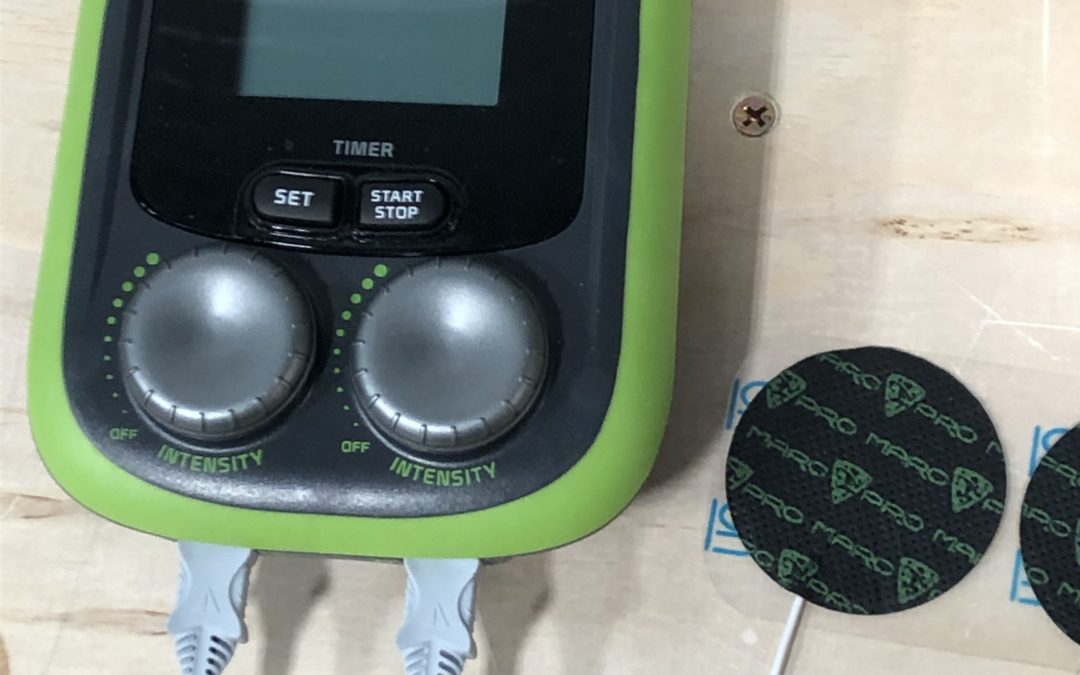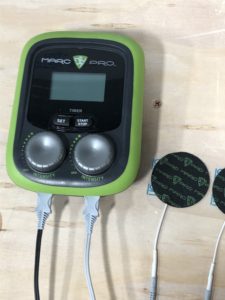Recovery is an important part of training at an elite level, and the most important pieces to recovery are the big three: monitoring training volume and intensity, nutrition, and sleep. Once you nail these aspects there are other recovery modalities to help you train at the highest level. However, with so many recovery modalities available it can be difficult to know which ones are effective and which ones are not. In this article series I will be evaluating various recovery methods focusing on the scientific research behind the modality, with a specific focus on its ability to help overhead throwers recover. The first modality I will be discussing is electrical muscle stimulation (EMS). EMS is a popular tool among athletes, but there are widely varied opinions about it among industry professionals.
What is EMS?
EMS is the use of a device that sends impulses to your motor nerves producing a muscle contraction. Electrodes are placed on or around sore areas of muscles and those muscles are then contracted and relaxed repeatedly for a predetermined period of time, often 15-30 minutes. Intensity and placement can be adjusted based on personal comfort.
The Theory
The theory behind EMS is that by stimulating the muscles to contract, you then drive blood into the respective muscle, which then flushes out metabolic by-products. The accumulation of metabolic by-products, such as hydrogen ions and diprotonated phosphate, interferes with actin-myosin interaction, reducing the ability of muscles to contract (Layzer, 1990). Therefore, EMS, in theory, can help clear some of these by-products faster than passive rest and help speed the recovery process, allowing athletes to return to their highest possible performance level faster. Also, since EMS produces muscle contractions without stress from external loading, it may be able to provide recovery benefits with less stress on the athlete’s body.
What Does the Research Say?
The theoretical benefits are encouraging, but can EMS effectively help athletes return to their highest level of performance faster by enhancing the recovery process? And if so, are throwers specifically helped by EMS?
Let’s dive into the research.
In my review of current research, two studies found objective performance benefits with the use of EMS for recovery (Taylor et al. 2015, Zarrouk et al. 2011). For example, the study by Taylor et al., involving professional rugby players, found that EMS mitigated the reduction in 24-hour post-exercise jump height, compared to athletes who did not use EMS. The rugby players who used EMS also reported significantly lower perceived soreness 24-hours post exercise (Taylor et al., 2015). And the study by Zarrouk et al. found that EMS was more effective than passive rest at maintaining peak torque during concentric knee extensions (Zarrouk et al., 2011).
Only one study examined the use of EMS with pitchers, however, they did find some positive benefits, in that that EMS was more effective than passive and active recovery at lowering blood lactate levels, and that EMS was more effective than active recovery at lowering rate of perceived exertion (RPE). However, passive rest was just as effective at lowering RPE (Warren et al., 2011).
Apart from the above three studies, there is little evidence showing objective evidence of benefits from EMS, as you can see from the following review and meta analysis.
A 2011 review by Babault et al. concluded that EMS showed positive effects on lactate removal and creatine kinase activity, but that there is a lack of evidence showing that it improves the speed of recovery of performance indicators, such as strength (Babault et al., 2011).
A meta analysis by Malone et al. found three studies with a positive outcome for EMS reducing subjective muscle pain, three for lowering blood lactate, one for lowering creatine kinase, and 1 for improving a performance parameter (Malone et al., 2014). Additionally, they found no evidence that EMS is superior to active recovery and mixed evidence that EMS is superior to passive recovery in terms of its effect on blood lactate levels (Malone et al., 2014).
Conclusions
There are a few important takeaways here. One, the research is mixed on the effectiveness of EMS as a recovery method, and more research is definitely needed.
Two, psychological factors play a significant role in sport performance and should not be ignored. For example, many of the studies show subjective recovery benefits with EMS where athletes had reduced “perceived” soreness and felt more prepared to perform at a high level. This could be do due a placebo effect, where athletes believe what they are doing is helping, so perceived benefit is derived. However, I don’t see that as a negative. If athletes believe they are helping themselves, and are more prepared to perform on the field, then they are likely to perform better.
Three, based on the current research, we cannot conclude whether throwers derive objective performance benefits from EMS. In terms of evaluating EMS’ effectiveness for recovery from pitching I would like to see research done in which pitchers use EMS after a game or after a high output throwing session and then take performance measures during the next game or next high output session rather than an in-game recovery scenario. Since most pitchers are using EMS for recovery between throwing sessions, this would seem to be the most relevant analysis. It would also be useful to examine its effectiveness as it relates to the velocity level of a pitcher. That is, does a high velocity or low velocity pitcher derive more benefit than the other, or are the effects similar, or non-existent? As with all research, especially related to performance, the population being studied is very important for application of the findings.
Finally, while in many cases active recovery does seem to be superior to EMS as a recovery method, EMS has been shown be more effective than passive recovery in some studies. Therefore, EMS could be a viable part of a recovery protocol, assuming it is not used exclusively. EMS shows little evidence of safety risks for healthy athletes (read the manual and talk to your doctor) as long as EMS is not overused. So, while the evidence on its effectiveness may be mixed, if athletes feel a subjective benefit from using EMS, then there is likely no harm in doing so.
Stay tuned as I continue to discuss other recovery methods and their overall effectiveness.
Resources
Layzer RB (2011) Muscle metabolism during fatigue and work. Baillieres Clinical Endocrinology and Metabolism.
Taylor T, West DJ, Howatson G, Jones C, Bracken RM, Love TD, Cook CJ, Swift E, Baker JS, Kilduff LP (2015) The impact of neuromuscular electrical stimulation on recovery after intensive, muscle damaging, maximal speed training in professional team sports players. Journal of Science and Medicine in Sport.
Zarrouk N, Rebai H, Yahia A, Souissi N, Hug F, Dogui M (2011) Comparison of Recovery Strategies on Maximal Force-Generating Capacity and Electromyographic Activity Level of the Knee Extensor Muscles. Journal of Athletic Training.
Warren CD, Szymanski DJ, Landers MR (2011) Effects of Three Recovery Protocols on Range of Motion, Heart Rate, Rating of Perceived Exertion, and Blood Lactate in Baseball Pitchers During a Simulated Game. Journal of Strength and Conditioning Research.
Babault N, Cometti C, Maffiuletti NA, Deley G (2011) Does electrical stimulation enhance post-exercise performance recovery? European Journal of Applied Physiology.
Malone JK, Blake C, Caufield BM (2014) Neuromuscular electrical stimulation during recovery from exercise: a systematic review. Journal of Strength and Conditioning Research.


